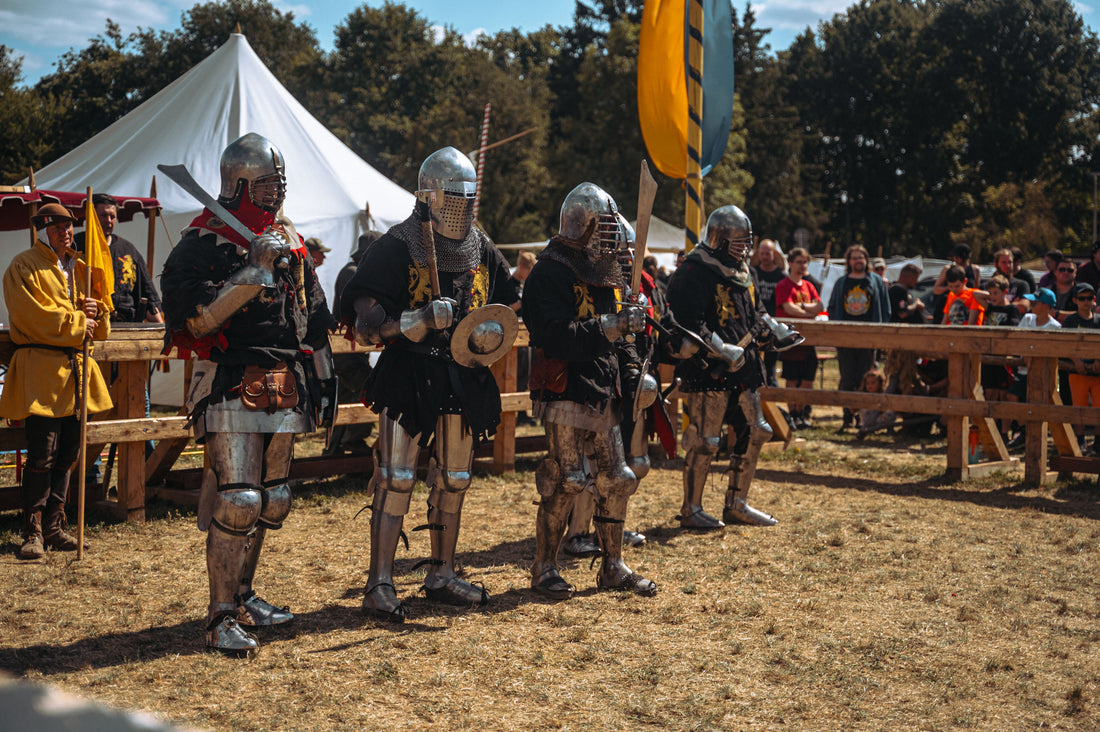
What is Buhurt?
Share
Buhurt: From Medieval Battlefields to Modern Arenas
When we think of medieval knights, the first images that come to mind are armored warriors clashing with swords, shields, and polearms in grand tournaments. What might surprise many, however, is that this ancient tradition not only survives today but has been reborn as a modern, international combat sport: Buhurt.
The Origins of Buhurt
The word Buhurt comes from the Old French term béhourd, which described a form of mock cavalry battle or melee that appeared in the 10th and 11th centuries. Unlike formal jousts, these events were chaotic clashes where groups of knights fought together with blunted weapons, testing their martial skill, endurance, and teamwork.
By the late Middle Ages, buhurts had become both entertainment and training for war. They were often featured at festivals and noble gatherings, sometimes involving dozens or even hundreds of fighters. But with the decline of knights and the rise of firearms, buhurts gradually faded into history, remembered mostly as colorful anecdotes of medieval chivalry.
The Revival in the Modern Era
Fast forward to the late 20th century: in Eastern Europe, history enthusiasts, reenactors, and martial artists began reviving historical armored combat. Instead of staged demonstrations, they aimed to recreate the intensity of medieval melee combat with authenticity and competition. This revival took root in Russia, Ukraine, and Poland, where the first organized leagues and federations emerged.
By the early 2000s, buhurt had grown into a structured sport, with international championships like the Battle of the Nations (founded in 2009) drawing teams from across the globe. Fighters wear historically accurate steel armor, often weighing 25–35 kilograms, and wield blunted replicas of medieval weapons. The rules are simple: strikes must be controlled, but full force is allowed, and the fight continues until one team brings down the majority of their opponents.
Buhurt as a Modern Combat Sport
Today, buhurt is a blend of historical martial arts, full-contact fighting, and team competition. There are different formats:
-
1 vs. 1 duels, which showcase individual skill with swords, axes, or polearms.
-
5 vs. 5 melees, the most popular form, where teamwork and tactics are crucial.
-
Mass battles, sometimes involving 30 fighters per side, recreating the chaos of medieval clashes.
Despite the brutality, safety is central. Fighters wear armor designed to absorb heavy blows, and referees enforce strict regulations on prohibited techniques (such as thrusting into gaps or attacking the neck).
The Global Spread and Community
What started in Eastern Europe has now spread worldwide. Clubs exist across Europe, the Americas, and Asia, with athletes from the U.S., Canada, Mexico, Brazil, Japan, and Australia joining the scene. The sport has even made its way into mainstream media, featured in documentaries and viral videos highlighting the raw, visceral appeal of “real-life knights.”
But beyond the fighting, buhurt is also a community. Fighters, armorers, historians, and fans come together around shared passion for medieval culture and combat. Events often mix competition with reenactment, medieval fairs, and music, creating a festival atmosphere that celebrates both history and sport.
Buhurt in Modernity
In many ways, buhurt reflects modern society’s fascination with blending past and present. It’s not just cosplay, nor merely sport—it’s a living embodiment of cultural heritage, reimagined through modern values of inclusivity and athleticism. Men and women compete, sometimes on the same teams. Training regimens borrow from MMA, wrestling, and strength sports, proving that this is no mere hobby but a serious athletic pursuit.
And while it stays true to medieval aesthetics, buhurt embraces modern technology: carbon steel armor improvements, sports medicine for recovery, and global livestreams that bring the clashing of steel to viewers’ screens.
Conclusion
Buhurt is more than knights in shining armor. It’s a fusion of history and modern sport, where ancient traditions find new expression in today’s world. What began as chaotic melees in medieval fields has transformed into a structured, international phenomenon—one that continues to grow and inspire.
So the next time you hear the clash of steel, it may not be the echo of the past—it may be buhurt’s modern warriors, keeping the spirit of medieval combat alive in the 21st century.
